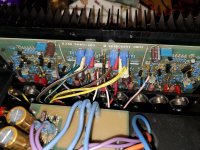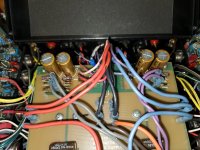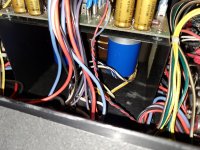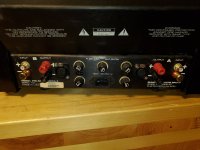Hi folks,
I have some parts of a rev C Andromeda II that I bought from another forum member who was unable to repair the amp. I would like to resurrect an amp from what I have, but I'm wondering if it's really worthwhile.
What I have are the boards... missing some output transistors and source resistors, and the transformer. He used the case for another project, and said the filter caps were dead (I'm surprised by that, since the filter caps from my rev A are still good after all these years).
Anyway, I would need a lot: case, thermal switches, power switch, filter caps, connectors, fuse holders, internal wiring, output transistors, etc.
I would also, and first, I think, need to depopulate one of the boards, scan it, create a layout from it, and have new boards made. These boards are in pretty bad shape, with lots of broken or peeling traces and some fiberglass damage from overheated components.
Then there's the question of outputs... the originals are IRFP9243 (Harris, NLA) and IRFP250 (?) or 240... I think that more modern IRFP9240/IRFP240 outputs would be feasible, but I'm not sure. I have not yet removed and tested all the twelve remaining outputs. The two I did remove tested OK... one was an IRFP9243 and the other was an IRFP250 (but reports are that 240s were used in these amps).
Overall, I'm looking at probably $400 to build a new amp from the ashes of the original. The Andromeda II is rated 200W into 8 Ohms, and 350W into 4 Ohms. It would be satisfying to build an amp from the parts I have, but would it be worthwhile? I don't need another amp - I actually have two "spares" already.
Thoughts?
Cheers, Paul
I have some parts of a rev C Andromeda II that I bought from another forum member who was unable to repair the amp. I would like to resurrect an amp from what I have, but I'm wondering if it's really worthwhile.
What I have are the boards... missing some output transistors and source resistors, and the transformer. He used the case for another project, and said the filter caps were dead (I'm surprised by that, since the filter caps from my rev A are still good after all these years).
Anyway, I would need a lot: case, thermal switches, power switch, filter caps, connectors, fuse holders, internal wiring, output transistors, etc.
I would also, and first, I think, need to depopulate one of the boards, scan it, create a layout from it, and have new boards made. These boards are in pretty bad shape, with lots of broken or peeling traces and some fiberglass damage from overheated components.
Then there's the question of outputs... the originals are IRFP9243 (Harris, NLA) and IRFP250 (?) or 240... I think that more modern IRFP9240/IRFP240 outputs would be feasible, but I'm not sure. I have not yet removed and tested all the twelve remaining outputs. The two I did remove tested OK... one was an IRFP9243 and the other was an IRFP250 (but reports are that 240s were used in these amps).
Overall, I'm looking at probably $400 to build a new amp from the ashes of the original. The Andromeda II is rated 200W into 8 Ohms, and 350W into 4 Ohms. It would be satisfying to build an amp from the parts I have, but would it be worthwhile? I don't need another amp - I actually have two "spares" already.
Thoughts?
Cheers, Paul
Where? Or is that what the last one that came up went for? They don't seem to be that common. I did find one for sale currently, for $850. Maybe from a shop that doesn't know how to service them (says they just adjusted the bias and DC offset... the DC offset on these is by servo, but there is a distortion null offset. Trying to set that by measuring DC offset doesn't seem like it would work well.)you can buy a complete second hand andromeda II for around $600. I think that says not worth it.
Distortion null is adjusted using a Distortion Analyzer such as a Sound Technology 1700B. The analyzer HAS to have a balanced input because both speaker terminals are hot.
Craig
Craig
Yes. I was pointing out that the place that has one currently for sale apparently does not know that. I used my HP 8903B to adjust mine.Distortion null is adjusted using a Distortion Analyzer such as a Sound Technology 1700B. The analyzer HAS to have a balanced input because both speaker terminals are hot.
Craig
I have a sumo Andromeda ii that I picked up in a package deal. Seller said it needed work but didn't elaborate. I came across your thread while googling info on this amp. I'm thinking this a is a bigger project than I can handle. I've had a peak under the hood on this one and it looks like there's been significant work done on this one already. Let me know if you're interested.
Attachments
I'm not sure how much work has been done there. As the D on the board says, there were several revisions to the Andromeda II. The later ones had TO-247 outputs instead of TO-3s. There are a number of added small caps here, but those may have been factory mods mid rev rather than alterations/repairs by a third party. Overall, from what I can see, it looks pretty good.
I have enough amplifiers at this point. I wouldn't mind some side gig repair work, but I recently moved to France, and am not yet settled, so that's really not an option right now.
No more details on what's wrong with the amp? Are any of the fuses blown?
I have enough amplifiers at this point. I wouldn't mind some side gig repair work, but I recently moved to France, and am not yet settled, so that's really not an option right now.
No more details on what's wrong with the amp? Are any of the fuses blown?
There are currently no fuses in the amp. I haven't even attempted to replace fuses or power it on. I do have a DBT and a variac. So far the extent of my audio repair has been simple replacement of old components. I'm not knowledgeable with diagnosis and troubleshooting.
The main problem with this particular version is the TO-3 Mosfets, damn near impossible to find and very expensive if you do find them.
Craig
Craig
First things to check with a meter would be whether the gates of any of the output MOSFETs (or the Zeners that are across them) are shorted, and also whether any of the outputs are shorted case to source. If these are Motorola devices MTM20N10 and MTM20P10, IIRC, the best source I've found for small quantity replacements is UTSource.
BTW, it's possible that if the load was shorted, it overdrove the gates and shorted the Zeners while not blowing the outputs. It has not been my experience that that was actually the case, but it's theoretically possible, so, if you do find shorted gates, you should pull the outputs and see if they're OK out of circuit. Out of circuit, you can test a MOSFET with a meter: Ohms mode, use + and - leads to charge the gate and verify that the source/drain read short; then use - and + leads to discharge the gate, and verify that source/drain read open.
BTW, it's possible that if the load was shorted, it overdrove the gates and shorted the Zeners while not blowing the outputs. It has not been my experience that that was actually the case, but it's theoretically possible, so, if you do find shorted gates, you should pull the outputs and see if they're OK out of circuit. Out of circuit, you can test a MOSFET with a meter: Ohms mode, use + and - leads to charge the gate and verify that the source/drain read short; then use - and + leads to discharge the gate, and verify that source/drain read open.
- Home
- Amplifiers
- Solid State
- Worth salvaging parts of a Sumo Andromeda II?



